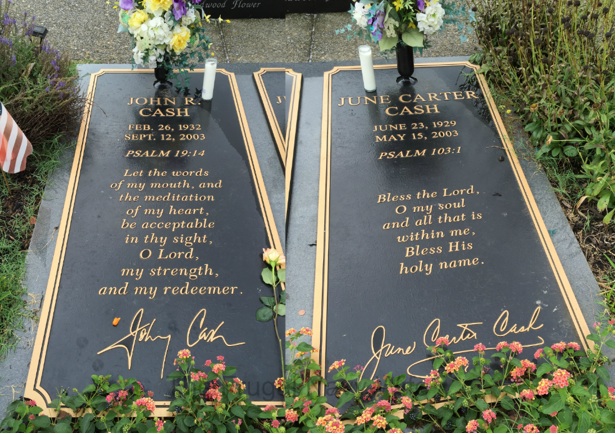“How well I have learned that there is no fence to sit on between heaven and hell. There is a deep, wide gulf, a chasm, and in that chasm is no place for any man”. Johnny Cash
Here it is almost 13 years since the “man in black” died (Sep.12, 2003). I met Johnny in1980 backstage at a concert in Salem, OR. He and the crew were joking with me about how I should move to Hendersonville, TN “where the real people lived”. Most of the entourage lived there including Johnny. I told them that I would “never” leave the Pacific Ocean, and besides that, “there was nothing but “rednecks” in the South”, although I thought that they might be an exception. They were extremely nice chaps and very professional to work with, nothing “redneck” about them.
Well here it is 2016 and I have lived here in Hendersonville, TN for six years now, it seems there is something about the over confident statement “never” …….. Johnny’s grave is 4 mi. from my house. Johnny’s property (house burned down Apr 10, 2007 after Barry Gibb purchased it) is a half mile from my gym. Oh yea, the main street here is “Johnny Cash Blvd” that I drive down every morning.
July 2, 2011, I was invited to a U2 concert at Vanderbilt Stadium by the U2 crew. A few days later some close friends, that live next to the graveyard where Johnny and June are buried, said that a limo had stopped by the gravesite and Bono stepped out to put some flowers on the grave.
I have never run into a musician, regardless of what country I was in that didn’t know who Johnny Cash was. His legacy will survive as long as there’s music, friends and fellow musicians say.
“He is the patron saint of every kid with a guitar,” said singer-songwriter Tom Waits. “Songwriters learn how to write songs from listening to each other. He’s like a wise old tree full of songs. I spent many days under his branches. His deeply lined face fit well with his voice, which was limited in range but used to great effect to sing about prisoners, heartaches and tales of everyday life”.
Cash wrote much of his own material and was among the first to record the songs of Bob Dylan and Kris Kristofferson.
“One Piece at a Time” was about an assembly line worker who built a car out of parts stolen from his factory. “A Boy Named Sue,” a Shel Silverstein song he took to No. 1 in 1969, was a comical story of a father who gives his son a girl’s name to make him tough.
Kristofferson, who wrote Cash’s 1970 hit “Sunday Morning Coming Down,” called the singer a “true American hero. He was always larger than life for me, and I’ve known him for over 30 years,” Kristofferson said.
Cash said in his self-titled 1997 autobiography that he tried to speak for “voices that were ignored or even suppressed in the entertainment media, not to mention the political and educational establishments.”
Each new generation found something of value in Cash’s records, many of which used his trademark rockabilly rhythm.
“His impact on country music and all music is up there in a very rarified atmosphere,” said Kyle Young, director of the Country Music Hall of Fame and Museum. “He was so accessible and his voice was so instantly recognizable. And he used really simple arrangements. When you listened to him you almost thought you could go out and make music yourself.”
Cash was a peer of Elvis Presley when he began recording in Memphis in the 1950s, and he scored hits like “Cry! Cry! Cry!” during that era. He had a longtime friendship and recorded with Dylan, who has cited Cash as a major influence.
Cash, who won 11 Grammy Awards, was elected to the Country Music Hall of Fame in 1980 and inducted into the Rock and Roll Hall of Fame in 1992.
“He united the downtrodden working man with the royalty of Europe. He could span all of what humanity is,” said singer-songwriter Rodney Crowell, who was once married to Roseanne Cash.
In his 1971 hit “Man in Black,” Cash said his black clothing symbolized the world’s downtrodden people.
In the 1990s, Cash found a new artistic life recording with rock-rap producer Rick Rubin on the label American Recordings. He was back on the charts in 2002 with the album “American IV: “The Man Comes Around.”
Ask someone to name a song that always has the power to reduce them to tears, and the chances are they’ll swiftly reply “Johnny Cash. Hurt.”
Most people know that it was originally an (excellent in its own right) Nine Inch Nails song, but exactly how the cover and its iconic music video were put together only adds to its resonance.
“To hear that Johnny was interested in doing my song was a defining moment in my life’s work,” Trent Reznor said. “To hear the result really reminded me how beautiful, touching and powerful music can be.”
The recording went ahead, produced by super producer Rick Rubin, and was released as a single in 2003, catching the ear of respected One Hour Photo director Mark Romanek.
“I begged Rick Rubin to let me shoot something to that track,” Romanek told Dave Urbanski in ‘the man comes comes around: “the spiritual journey of Johnny Cash” who was instantly enamoured of the rendition and even offered to shoot the video for free.
Universal agreed to the music video, the original conception for the video thrown out the window, Rick Romanek began scouting potential filming locations, leading him to Cash’s home and museum, The House of Cash. “I cried the first time I saw it, It had been closed for a long time,” the director recalled. “The place was in such a state of dereliction. That’s when I got the idea that maybe we could be extremely candid about the state of Johnny’s health – as candid as Johnny has always been in his songs.”
That idea would blossom into a heart-wrenching music video, that spoke about the transience of life, the gracelessness of death, the Ozymandian crumbling of an oeuvre and the decline of a genre, an era and an attitude.
The ‘closed to public’ sign on the museum. The cracked platinum records. The caviar and lobster banquet with no diners. The clips from earlier in Johnny’s career. His wife June looking on. The closed piano lid. The tears well at different times for different viewers -for me it’s always the pouring of the wine from Cash’s frail hand.
Rick Rubin now sees the video as a historical document. “I cried the first time I saw it,” he said. “If you were moved to that kind of emotion in the course of a two-hour movie, it would be a great accomplishment. To do it in a four-mnute music video is shocking.”

